Your gateway to endless inspiration
Space Telescopes - Blog Posts
What’s Inside a ‘Dead’ Star?
Matter makes up all the stuff we can see in the universe, from pencils to people to planets. But there’s still a lot we don’t understand about it! For example: How does matter work when it’s about to become a black hole? We can’t learn anything about matter after it becomes a black hole, because it’s hidden behind the event horizon, the point of no return. So we turn to something we can study – the incredibly dense matter inside a neutron star, the leftover of an exploded massive star that wasn’t quite big enough to turn into a black hole.

Our Neutron star Interior Composition Explorer, or NICER, is an X-ray telescope perched on the International Space Station. NICER was designed to study and measure the sizes and masses of neutron stars to help us learn more about what might be going on in their mysterious cores.

When a star many times the mass of our Sun runs out of fuel, it collapses under its own weight and then bursts into a supernova. What’s left behind depends on the star’s initial mass. Heavier stars (around 25 times the Sun’s mass or more) leave behind black holes. Lighter ones (between about eight and 25 times the Sun’s mass) leave behind neutron stars.

Neutron stars pack more mass than the Sun into a sphere about as wide as New York City’s Manhattan Island is long. Just one teaspoon of neutron star matter would weigh as much as Mount Everest, the highest mountain on Earth!

These objects have a lot of cool physics going on. They can spin faster than blender blades, and they have powerful magnetic fields. In fact, neutron stars are the strongest magnets in the universe! The magnetic fields can rip particles off the star’s surface and then smack them down on another part of the star. The constant bombardment creates hot spots at the magnetic poles. When the star rotates, the hot spots swing in and out of our view like the beams of a lighthouse.

Neutron stars are so dense that they warp nearby space-time, like a bowling ball resting on a trampoline. The warping effect is so strong that it can redirect light from the star’s far side into our view. This has the odd effect of making the star look bigger than it really is!

NICER uses all the cool physics happening on and around neutron stars to learn more about what’s happening inside the star, where matter lingers on the threshold of becoming a black hole. (We should mention that NICER also studies black holes!)

Scientists think neutron stars are layered a bit like a golf ball. At the surface, there’s a really thin (just a couple centimeters high) atmosphere of hydrogen or helium. In the outer core, atoms have broken down into their building blocks – protons, neutrons, and electrons – and the immense pressure has squished most of the protons and electrons together to form a sea of mostly neutrons.
But what’s going on in the inner core? Physicists have lots of theories. In some traditional models, scientists suggested the stars were neutrons all the way down. Others proposed that neutrons break down into their own building blocks, called quarks. And then some suggest that those quarks could recombine to form new types of particles that aren’t neutrons!

NICER is helping us figure things out by measuring the sizes and masses of neutron stars. Scientists use those numbers to calculate the stars’ density, which tells us how squeezable matter is!
Let’s say you have what scientists think of as a typical neutron star, one weighing about 1.4 times the Sun’s mass. If you measure the size of the star, and it’s big, then that might mean it contains more whole neutrons. If instead it’s small, then that might mean the neutrons have broken down into quarks. The tinier pieces can be packed together more tightly.

NICER has now measured the sizes of two neutron stars, called PSR J0030+0451 and PSR J0740+6620, or J0030 and J0740 for short.
J0030 is about 1.4 times the Sun’s mass and 16 miles across. (It also taught us that neutron star hot spots might not always be where we thought.) J0740 is about 2.1 times the Sun’s mass and is also about 16 miles across. So J0740 has about 50% more mass than J0030 but is about the same size! Which tells us that the matter in neutron stars is less squeezable than some scientists predicted. (Remember, some physicists suggest that the added mass would crush all the neutrons and make a smaller star.) And J0740’s mass and size together challenge models where the star is neutrons all the way down.

So what’s in the heart of a neutron star? We’re still not sure. Scientists will have to use NICER’s observations to develop new models, perhaps where the cores of neutron stars contain a mix of both neutrons and weirder matter, like quarks. We’ll have to keep measuring neutron stars to learn more!
Keep up with other exciting announcements about our universe by following NASA Universe on Twitter and Facebook.
Make sure to follow us on Tumblr for your regular dose of space: http://nasa.tumblr.com.
Three NASA Telescopes Look at an Angry Young Star Together
Science is a shared endeavor. We learn more when we work together. Today, July 18, we’re using three different space telescopes to observe the same star/planet system!

As our Transiting Exoplanet Survey Satellite (TESS) enters its third year of observations, it's taking a new look at a familiar system this month. And today it won't be alone. Astronomers are looking at AU Microscopii, a young fiery nearby star – about 22 million years old – with the TESS, NICER and Swift observatories.

TESS will be looking for more transits – the passage of a planet across a star – of a recently-discovered exoplanet lurking in the dust of AU Microscopii (called AU Mic for short). Astronomers think there may be other worlds in this active system, as well!

Our Neutron star Interior Composition Explorer (NICER) telescope on the International Space Station will also focus on AU Mic today. While NICER is designed to study neutron stars, the collapsed remains of massive stars that exploded as supernovae, it can study other X-ray sources, too. Scientists hope to observe stellar flares by looking at the star with its high-precision X-ray instrument.

Scientists aren't sure where the X-rays are coming from on AU Mic — it could be from a stellar corona or magnetic hot spots. If it's from hot spots, NICER might not see the planet transit, unless it happens to pass over one of those spots, then it could see a big dip!

A different team of astronomers will use our Neil Gehrels Swift Observatory to peer at AU Mic in X-ray and UV to monitor for high-energy flares while TESS simultaneously observes the transiting planet in the visible spectrum. Stellar flares like those of AU Mic can bathe planets in radiation.
Studying high-energy flares from AU Mic with Swift will help us understand the flare-rate over time, which will help with models of the planet’s atmosphere and the system’s space weather. There's even a (very) small chance for Swift to see a hint of the planet's transit!

The flares that a star produces can have a direct impact on orbiting planets' atmospheres. The high-energy photons and particles associated with flares can alter the chemical makeup of a planet's atmosphere and erode it away over time.
Another time TESS teamed up with a different spacecraft, it discovered a hidden exoplanet, a planet beyond our solar system called AU Mic b, with the now-retired Spitzer Space Telescope. That notable discovery inspired our latest poster! It’s free to download in English and Spanish.

Spitzer’s infrared instrument was ideal for peering at dusty systems! Astronomers are still using data from Spitzer to make discoveries. In fact, the James Webb Space Telescope will carry on similar study and observe AU Mic after it launches next year.
Make sure to follow us on Tumblr for your regular dose of space: http://nasa.tumblr.com
Cosmic Piece of Pi!
Did you know that pi is involved nearly anywhere you look? We’re not talking about your favorite pastry! Pi (also written as the Greek letter 𝞹, or the number 3.14159...) is an irrational number, which means it can’t be written as a simple fraction like ½. It is the ratio of a circle’s circumference (the distance around its edge) to its diameter (the distance across it) and will always be the same number, regardless of the circle’s size. Here are some places you can find pi in the universe around us!

Our Transiting Exoplanet Survey Satellite, TESS, watches slices of the sky in its hunt for worlds outside our solar system — how many exoplanets are in its night-sky pie? Last July, TESS scientists created a mosaic of 208 images of the southern sky. At that time, it contained 29 confirmed and 1,000 possible exoplanets, and we’re still studying the data to find more. Since this awe-inspiring image is of the southern hemisphere (or half of a 3D circle), there will always be pi! Every slice contains something delicious for scientists to study.

Pi recently played a crucial role in new discoveries about Alpha Draconis, a well-studied pair of stars. After discovering these stars regularly eclipse each other, pi helped scientists learn more about them. Scientists detected the eclipses while monitoring the brightness of Alpha Draconis for periodic dips that could’ve been caused by planets passing between the star and us. Instead of a planet, though, researchers found that its smaller partner in crime was passing in between us and the larger star for about six hours at a time! 💫

Pi comes in handy as we learn more about these two stars. Knowing the percentage of the decrease in Alpha Draconis’ light and the formula for the area of a circle (A=𝞹r2 — or area equals pi times the square of the circle's radius), scientists can predict the sizes of both stars. Because stars typically orbit in an elliptical (or oval) shape, pi also helps scientists use the detection of these eclipses to figure out the orbits of the two stars!
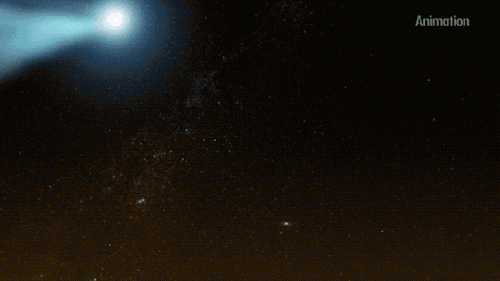
So far we’ve seen pi in many places! But it's also interesting to look at where pi can't be found! We mentioned earlier that many orbit calculations involve pi … but not every one does! Pi does not factor into calculations of hyperbolic orbits — orbits that aren't complete, or don't return to where they started — the same way that it does with elliptical orbits! This is most commonly seen with comets. While many comets orbit normally in our solar system, some oddballs just pass through, like the interstellar ‘Oumuamua that zipped passed us in 2017. ☄️

Perhaps the most popular place you may find pi is in the shape of a typical pie! While NASA’s Fermi Gamma-ray Space Telescope studies gamma-rays, and not blueberries, we think this cool Fermi pie is worth sharing for Pi Day!
Find more ways scientists look up at the night sky and use pi here. And now, don’t be irrational, and go have some pi(e)! 🥧
Make sure to follow us on Tumblr for your regular dose of space: http://nasa.tumblr.com

Say hello to the Butterfly Nebula 👋
It looks like our Hubble Space Telescope captured an image of a peaceful, cosmic butterfly unfurling its celestial wings, but the truth is vastly more violent. In the Butterfly Nebula, layers of gas are being ejected from a dying star. Medium-mass stars grow unstable as they run out of fuel, which leads them to blast tons of material out into space at speeds of over a million miles per hour!
Streams of intense ultraviolet radiation cause the cast-off material to glow, but eventually the nebula will fade and leave behind only a small stellar corpse called a white dwarf. Our middle-aged Sun can expect a similar fate once it runs out of fuel in about six billion years.
Planetary nebulas like this one aren’t actually related to planets; the term was coined by astronomer William Herschel, who actually discovered the Butterfly Nebula in 1826. Through his small telescope, planetary nebulas looked like glowing, planet-like orbs. While stars that generate planetary nebulas may have once had planets orbiting them, scientists expect that the fiery death throes these stars undergo will ultimately leave any planets in their vicinity completely uninhabitable.
Make sure to follow us on Tumblr for your regular dose of space: http://nasa.tumblr.com.
How Do We Learn About a Planet’s Atmosphere?
The first confirmation of a planet orbiting a star outside our solar system happened in 1995. We now know that these worlds – also known as exoplanets – are abundant. So far, we’ve confirmed more than 4000. Even though these planets are far, far away, we can still study them using ground-based and space-based telescopes.
Our upcoming James Webb Space Telescope will study the atmospheres of the worlds in our solar system and those of exoplanets far beyond. Could any of these places support life? What Webb finds out about the chemical elements in these exoplanet atmospheres might help us learn the answer.
How do we know what’s in the atmosphere of an exoplanet?
Most known exoplanets have been discovered because they partially block the light of their suns. This celestial photo-bombing is called a transit.

During a transit, some of the star's light travels through the planet's atmosphere and gets absorbed.

The light that survives carries information about the planet across light-years of space, where it reaches our telescopes.
(However, the planet is VERY small relative to the star, and VERY far away, so it is still very difficult to detect, which is why we need a BIG telescope to be sure to capture this tiny bit of light.)
So how do we use a telescope to read light?

Stars emit light at many wavelengths. Like a prism making a rainbow, we can separate light into its separate wavelengths. This is called a spectrum. Learn more about how telescopes break down light here.

Visible light appears to our eyes as the colors of the rainbow, but beyond visible light there are many wavelengths we cannot see.
Now back to the transiting planet...
As light is traveling through the planet's atmosphere, some wavelengths get absorbed.

Which wavelengths get absorbed depends on which molecules are in the planet's atmosphere. For example, carbon monoxide molecules will capture different wavelengths than water vapor molecules.

So, when we look at that planet in front of the star, some of the wavelengths of the starlight will be missing, depending on which molecules are in the atmosphere of the planet.

Learning about the atmospheres of other worlds is how we identify those that could potentially support life...

...bringing us another step closer to answering one of humanity's oldest questions: Are we alone?

Watch the full video where this method of hunting for distant planets is explained:
To learn more about NASA’s James Webb Space Telescope, visit the website, or follow the mission on Facebook, Twitter and Instagram.
Text and graphics credit Space Telescope Science Institute
Make sure to follow us on Tumblr for your regular dose of space: http://nasa.tumblr.com.
How Do Space Telescopes Break Down Light?
Space telescopes like Hubble and our upcoming James Webb Space Telescope use light not only to create images, but can also break light down into individual colors (or wavelengths). Studying light this way can give us a lot of detail about the object that emitted that light. For example, studying the components of the light from exoplanets can tell us about its atmosphere’s color, chemical makeup, and temperature. How does this work?
Remember the primary colors you learned about in elementary school?
Those colors are known as the pigment or subtractive colors. Every other color is some combination of the primary colors: red, yellow, and blue.

Light also has its own primary colors, and they work in a similar way. These colors are known as additive or light colors.
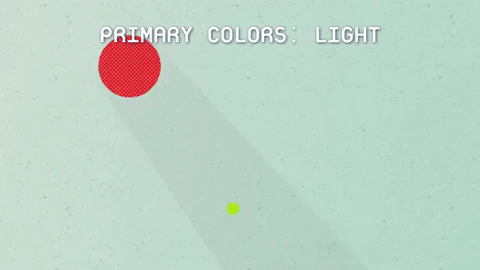
TVs make use of light’s colors to create the pictures we see. Each pixel of a TV screen contains some amount of red, green and blue light. The amount of each light determines the overall color of the pixel. So, each color on the TV comes from a combination of the primary colors of light: red, green and blue.

Space telescope images of celestial objects are also a combination of the colors of light.
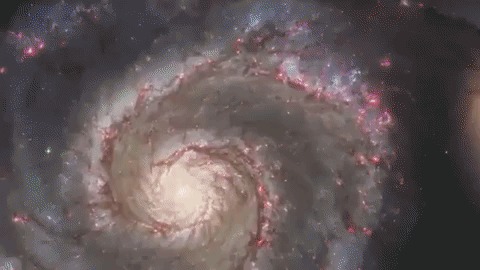
Every pixel that is collected can be broken down into its base colors. To learn even more, astronomers break the red, green and blue light down into even smaller sections called wavelengths.
This breakdown is called a spectrum.

With the right technology, every pixel of light can also be measured as a spectrum.

Images show us the big picture, while a spectrum reveals finer details. Astronomers use spectra to learn things like what molecules are in planet atmospheres and distant galaxies.
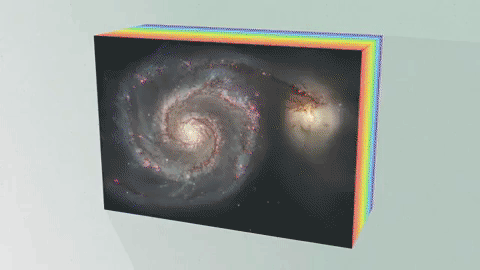
An Integral Field Unit, or IFU, is a special tool on the James Webb Space Telescope that captures images and spectra at the same time.
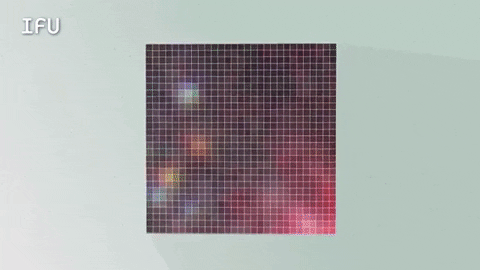
The IFU creates a unique spectrum for each pixel of the image the telescope is capturing, providing scientists with an enormous amount of valuable, detailed data. So, with an IFU we can get an image, many spectra and a better understanding of our universe.
Watch the full video where this method of learning about planetary atmospheres is explained:
The James Webb Space Telescope is our upcoming infrared space observatory, which will launch in 2021. It will spy the first galaxies that formed in the universe and shed light on how galaxies evolve, how stars and planetary systems are born and tell us about potentially habitable planets around other stars.
To learn more about NASA’s James Webb Space Telescope, visit the website, or follow the mission on Facebook, Twitter and Instagram.
Text and graphics credit: Space Telescope Science Institute
Make sure to follow us on Tumblr for your regular dose of space: http://nasa.tumblr.com.